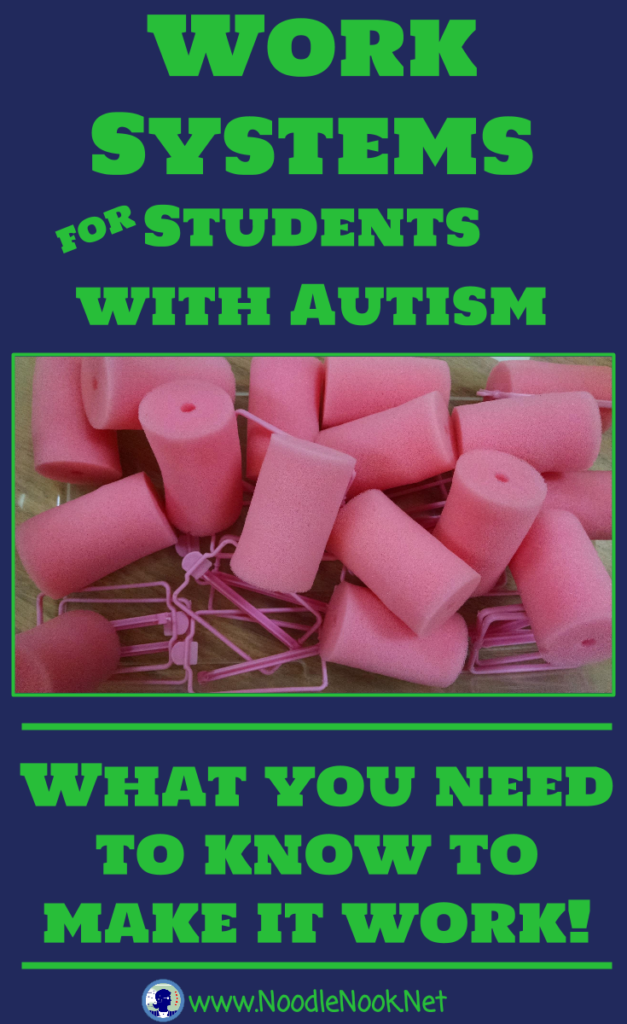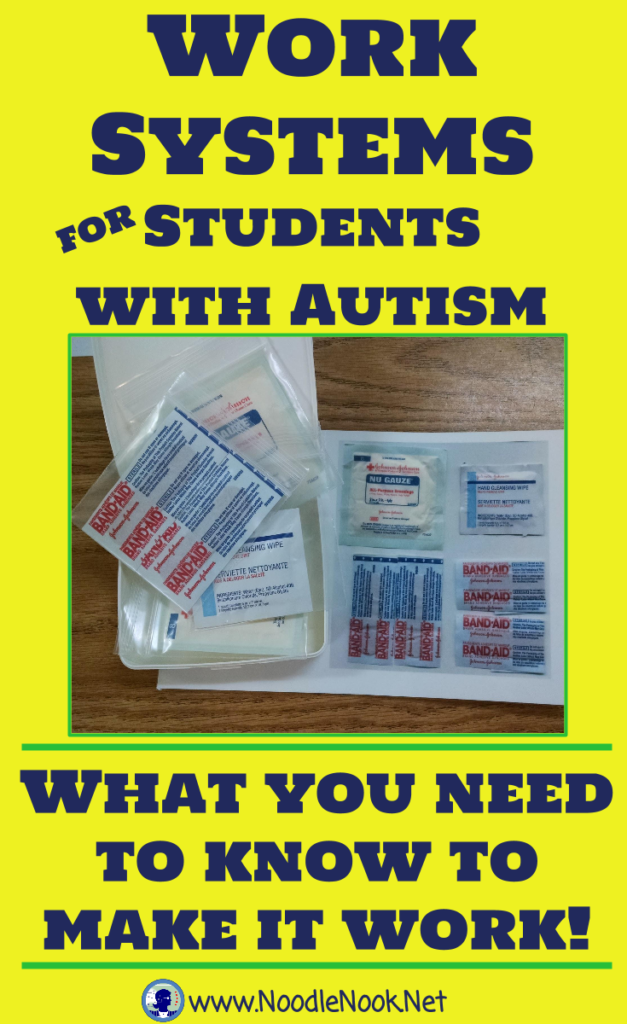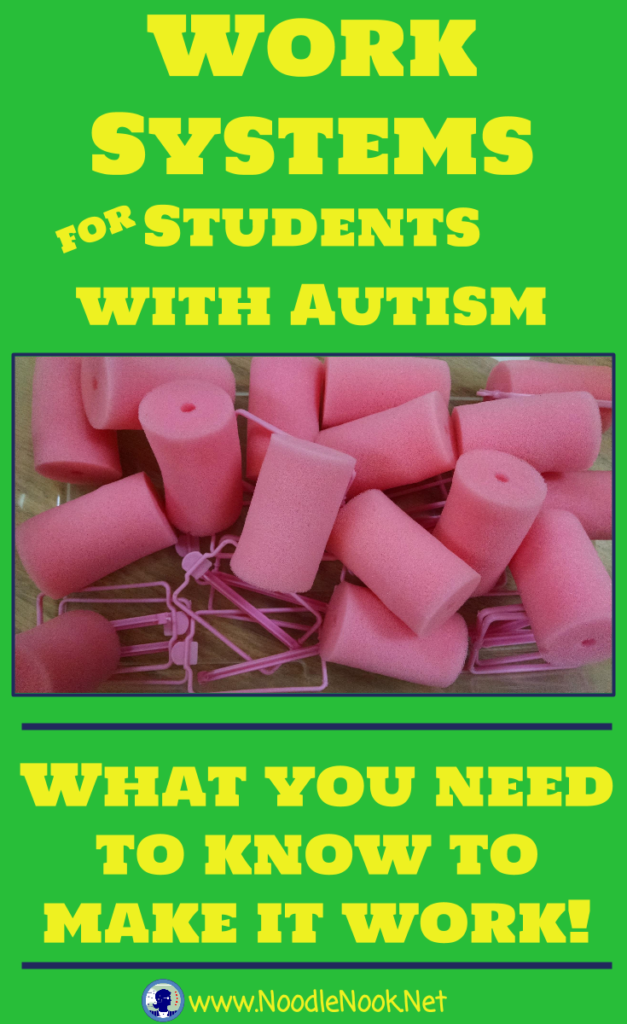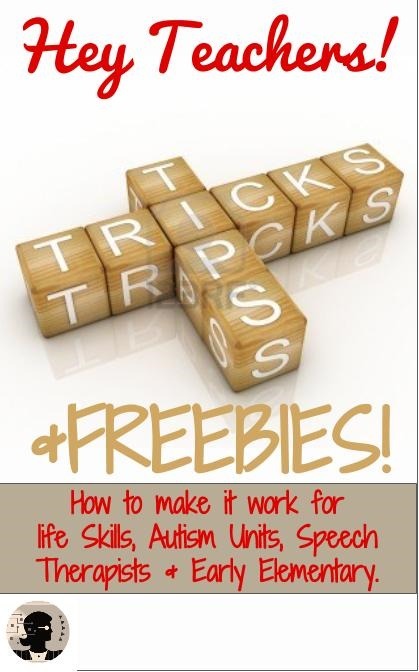Work Tasks for Students with Autism
You are not the first teacher to think that everyone in your classroom feels like a 1:1 student… they all need help! It is overwhelming to think of how to meet the needs of everyone in your room. Great news is there is a way to help bring calm to your room and some sanity to your mind. You have to have some independent work tasks!
What Are Work Tasks?
There are a few things you have to know before you start using work tasks in your classroom. No matter the task you use, the system only works if your students can answer these 4 questions about the task:
- What work do I have to do?
- How much work do I have to do?
- How will I know when I am finished?
- What will happen when I am finished?
We are going to break down these four areas down. But, as we discuss them, I really want you to think about how you can incorporate a work system into your classroom- they are a key tool for students, especially those with Autism, to be able to sequence steps, work towards independence, and generalize skills and information.
Work tasks are also a great predictable part of the day and the work task routine can be powerful in establishing an element of familiarity and lessening anxiety, even in new environments. Research on the effects of work tasks has shown when used appropriately they increase on task behavior and reduce teacher prompts. You can build independence with this type of system and remove that feeling of always needing 1:1 in your classroom
WARNING: Task boxes and work systems are not meant to be the only part of a student’s day- mindlessly completing task box after task box or, worse yet, a single task box over and over again is not the purpose of this system. If you are guilty of this, please read on…
Work Tasks: What Work Do I Do?
The number one thing a student needs to know as they start this system is what you want them to do. If you are making a kit you can use visual directions and/or written directions, picture representations work great too. You will want to model the procedures for a student so they know how to get the task done. Above all, when you model, you are modeling appropriate behavior and steps.
I watched a para give a student a task box with little or no direction look back. When she looked back the kit was in pieces and a portion of the kit was in the student’s mouth. It is not enough to slap a kit in front of a student- you have to show them what you want them to do and how.
And I have to mention the posts that talk about visuals- with a work system, visuals are perfectly poised to support a student and help them to get through the steps in a process appropriately. You should have visual supports in place and, if visuals are not appropriate because of a student’s functioning level, the written supports in place for a student to be successful.
Work Tasks: How Much Do I Do?
The next question every student needs to know the answer to is how much do I gotta do… Do you want ten sets? Do you want them to work for 10 minutes? Is 2 minutes enough? Another thing to teach at this point is the quality of work you expect. If the job is done but all the materials are messy, will you accept it?
I had a student once who just wanted to get the job done. Whenever he completed a task it was always messy and not quite right. I started to return him to the task until it was done correctly and cleanly- and I modeled what that looked like to him. After some training, I started to get better quality. And that matters.
[tweetthis]What you need to be successful with Work Tasks in Autism Units- Super Helpful![/tweetthis]
Work Tasks: How Do I Know When I’m Done?
How do I know when I’m done? When I do the dishes I am done when the sink is empty. When I do laundry, it is not done when I load the washer… or when I load the dryer. Laundry isn’t done until it is all put away (course I have 4 kids- laundry is never done)!
So how will your students know when they are done? Will a timer go off? Will they have to finish all the steps in a sequence? Will they complete a task and be rewarded by you are check with you to get “graded”? Or will all the work to do be removed from their area because it has all be completed?
No matter the procedure you put into place, there has to be a ‘done’.
Work Tasks: What Do I Get When I Finish?
And this is the most important part- the payoff! What have I been working for? Was it a break? Preferred activity? Or positive praise? You have to have a consequence for the good work. As an adult, I get my paycheck for my work! I know I wouldn’t go to work everyday without it- would you? It keeps us motivated!
I Get It… Now What?
Now it is time to design your work system. You understand the needs on the front end- but what do the students actually work on? There are a couple of basic skills most work tasks fall under. For vocational tasks, they are typically:
- Assembly
- Sorting
- Put-In
- And Coordination Tasks
With Assembly Tasks, students are filling orders or gathering items in a set. Typically this type of activity requires correct sequencing to get the job done right. An example of this may be putting toothbrushes into matching cases or packaging a comb, brush and mirror into a set.
Sorting Tasks require determining the attributes of an item and categorizing it- which is a great pre-vocational skill and also a needed skill in math. Examples of sorting tasks can be separating items based on shape, color, or size… or even sorting coins by value! All these fall into the sorting category.
Put In Tasks are just that- students put items into a container or opening. Students can do something as basic as putting straws into cups or clothespins into containers. Often the opening is pre-sized for the item that goes in so there is a ‘right’ way and a ‘wrong’ way.
Finally, Coordination Tasks are ones that require some hand-eye coordination or finger dexterity to complete. Examples of coordination tasks are things like pulling the beads off of a string or putting beads on pipe cleaner. These kinds of tasks work on squeezing, pulling, and fine motor skills.
Hold On! Tips Ahead…
You’re a true believer now… but there are a few things you need to remember!
- Make sure all the materials to complete the task or activity are provided and accessible. It helps if the materials are all contained in a task box or basket, but if that is not a possibility be sure the list of materials is available with visual supports.
- Think about having some portable tasks. It is inevitable- you’ll have to clear your room at some point, whether that is for a behavior, a seizure, or a furry critter. When you have some systems that are easily moved, it can go with you- along with your established routine and procedure.
- Be aware of what students like! If they are head over heels for all things basketball, then can you figure out a way to incorporate basketball into the task system? Either with visuals or actual materials? That may make the difference between compliance and behavior!
- Try to generalize skills. Don’t sit a student in front of the same task box all day everyday week after week. Generalize those skills- so if a student is working with an assembly task can they transfer the skills they are learning to a different assembly task? Have more than one available so generalization is an option.
- Be sure you are not a step in the system. Work systems are meant to be independent. You should not be present to cue and prompt at every turn- that means it’s not independent. The students should be able to complete all the steps without you in the routine. Not sure how to do that? Read our previous posts on visual structure and physical structure and think of how that can help you!
I Still Need More!
Okay- You are 100% into the work system method… but you need to set up some activities. Where do you start? Check back next week where you’ll find a FREE printable task box setup along with tons of ideas for more that you can pick up from the dollar store! Who doesn’t love that?
Want to make sure you get your in your inbox? Subscribe now so you don’t miss a thing!
Recapping this Series about Setting up a Structured Classroom
When it comes to setting up a Structured Classroom in LIFE Skills or an Autism Unit, Work Tasks are only part of the puzzle. You will also need:
Check out the posts where we talk about these things and more by clicking above. Also take a second to read about ABA and Autism– It will help you as you are setting things up or reestablishing your classroom procedures and routines.
Article Citation: [cite]







